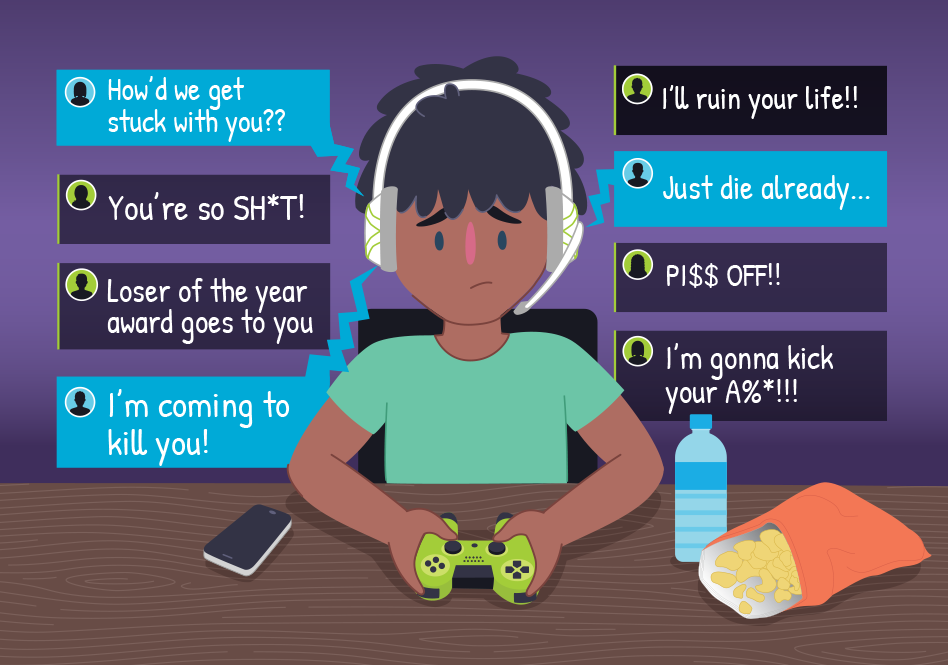Cyberbullying (or cyberharassment) is bullying that happens online over digital devices like mobile phones, computers, etc. Usually being an extension of real-life bullying, cyberbullying includes teasing, intimidation, threat, demonstration of dominance, coercion, insult, etc. Just as common bullying, online harassment is repetitive aggression that emphasizes an imbalance of power.
The difference is made by the more intense psychological tension that victims suffer, as cyberbullying, despite being less “physical,” creates a higher density of harassment since victims and aggressors are almost always online.
As the phenomenon is more likely to occur in hard-to-escape semi-closed communities like schools, cyberbullying often remains unknown. In countries where bullying is out of the law, cyberbullying is also illegal.
How Does It Work
So, what is cyberbullying? Cyberbullying occurs mainly on social media, especially on Facebook (which works as a magnifying glass of all social processes), in messenger apps on phones and tablets. Harassment is also possible on forums, message boards, and other online platforms for theme-based discussions. Emails are also used, especially for threats.
Although SMS might also be regarded as a channel of cyberbullying, it is not. Classic short messages remain a form of modernized ordinary bullying. What is specific about the disputed phenomenon is that cyberharassment gains some peculiar features. People stay online most of their wake time.
Cyberbullying in Online Communities?
People mostly associate their leisure time with being online. Therefore cyberbullying is a modern and intensified version of bullying. People cannot simply leave the environment where the mockery happens because, in the case of the Internet and social media, victims tie their hopes with the same space where the harassment takes place. It is hardly thinkable for a modern person to leave social media or the Internet whatsoever.
Cyberbullying in communities of online computer games is the most representative phenomenon, as nobody forces the victims of harassment to participate in those communities. But that is precisely how cyberbullying works! People are bullied in that very place where they expect to find joy. Unlike that, real-life harassment most often happens in groups wherein people are forced or need to participate.
Lawas and Regulations
Cyberbullying is illegal in countries where common bullying is banned. There is no reason to downplay the significance of Internet bullying against real-life harassment, especially considering that written messages were always typical of old-fashioned mockery and threats. The presence of evidence (chat logs, emails, screenshots, audio/video records) only makes investigations easier. Authorities can either interpret cyberbullying as a case of usual harassment or, if local legislation allows it, classify the violation as cyberbullying itself.
What varies throughout countries is whether the offense is considered a crime or an administrative violation. There are sub-cases of bullying that are especially sensitive in the context of criminal responsibility. These activities are violent threats, blackmail, and stalking.
Examples Of Cyberbullying In Social Media
Lawyers who deal with cyberbullying experience difficulties because harassment on the Internet is an age-related disease in children and adolescents. Governments do their best to spare school kids from being prosecuted as criminals, so schools are given a lot of power to stop cyberbullying as a local phenomenon through organizational methods. In some states, however, and countries, general intention, flagrant cases, such as intimidation, can be taken to court even with the juvenile delinquent. It is so, for example, in the state of Missouri (US.)
Six stories listed below are cases of cyberbullying that led to the death of the victims. These tragedies happened within a time span of sixteen years and reflect different aspects of cyberbullying.
- Story #1. Ryan Halligan was a school student whose emotional insecurity was exploited during two years of his school time, from his fifth to seventh grade. Cyberbullying episode was Ryan’s communication over AOL Instant Messenger with the girl who made Halligan believe she was romantically engaged with him. As it turned out, the romance was staged. In 2003 Halligan hanged himself in the bathroom at home.
- Story #2. Megan Meier was a 13-years old girl who committed suicide in 2006 after receiving insulting and mocking messages on MySpace. The death of Megan became a starting point for a court process that led to the eventual acquittal of the accused person. Tendencies were obvious: Federal grand jury indicted the harasser, a Missouri woman, but a district judge acquitted her.
- Story #3. Jessica Logan, a Sycamore High School student whose nude photo was spread on the Internet by her ex-boyfriend, underwent bullying on MySpace and Facebook platforms. She killed herself in 2008. Jessica’s parents filed a lawsuit against the university for not stopping the harassment of their daughter despite being informed about it. The 2012 Jessica Logan Act expanded anti-harassment policies addressing cyberbullying.
- Story #4. Tyler Clementi was a Rutgers University student whose kiss with a man was streamed via a webcam. The spreading of the video led to a form of mockery of Tyler by his mates. Tyler Clementi killed himself by jumping off a bridge in 2010. Tyler Clementi Higher Education Anti-Harassment Act was introduced after the case and reintroduced in 2013. This act would require colleges and universities to have anti-harassment policies.
- Story #5. Amanda Todd was a victim of cyberstalking by a person who previously fished a topless photo out of Amanda and then shared it on social media. Amanda changed schools after bullying, but the stalker kept befriending her again and again from a secret account. After posting a video on YouTube about her sorry experience in 2012, Amanda Todd eventually hanged herself.
Why is Cyberbullying a Problem?
Stopping cyberbullying, just like real-life bullying, is a matter of upbringing, creating a healthy atmosphere within communities, and wise reaction to harassment in case the latter has already happened. Cyberbullying is more problematic than “normal” because of its invisibility. Neither teachers nor school psychologists can witness harassment happening in closed communities on social media. Even less penetrable is direct messaging.
How to Stop Cyberbullying
People responsible for the wholesomeness of endangered groups should be vigilant, watching out for signs of bullying among their wards. Cyberbullying is only a temptation for those people who have nothing more interesting to do. Therefore, keeping students busy with captivating tasks and maintaining their moral self-esteem high, especially in schools, is crucial. If you are a victim of cyberbullying:
- Do not blame yourself. Make no mistake here. No one deserves cruel and aggressive treatment.
- Do not respond. Sometimes your reaction is what bullies are after. If you stop reacting, their interest in you might run dry. If you cannot ignore them, make sure your response is calm, firm, and civilized.
- Save the evidence. Don’t remove intimidating or mockery emails, messages, audio records, videos, etc. Don’t forget to take screenshots of chats where harassment takes place. Many messengers have a function of chat deletion.
- Tell the harassers to stop. It might seem silly and ineffective, but in many cases, the impudent behavior of harassers is explained by the fact that while they are aware of what they are doing, their victim does not understand what is happening to them. Making offenders know that you can see the whole picture might make them cease the harassment.
- Seek help from an adult and experienced person you trust. If you do not have such a person – find one. Parents, psychologists, and even police fit that role.
- Block and report accounts of the harassers. Social networks feature these functions for a reason, and cyberbullying is a good reason to apply them.
- Protect your data. If you find yourself in a cyberbullying situation, make sure offenders do not get their hands on your private information. Use 2-factor authentication on your accounts, log out from public devices, do not share sensitive information, and block screens on your portable devices.
Most Common Effects of Cyberbullying
Example of cyberbullying has its own dangers compared to “classic” localized harassment. Sensitive information on the victim, which is usually a ground for bullying, can be spread without any boundaries via the all-penetrating Net, so changing location, schools, etc., is no longer effective against mockery. Realizing the world-wide-web as the arena for harassment creates angst in victims, an ultimate fear of not being able to avoid bullying.
Cyberbullying is a traumatic experience that causes anxiety, loss of dignity, fear of people, general distrust, and avoidance of social connections. These factors altogether lead to desperation and suicidal tendencies.





